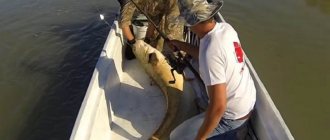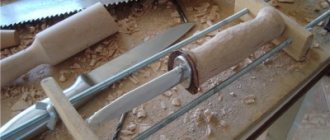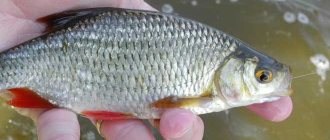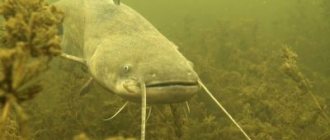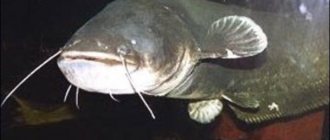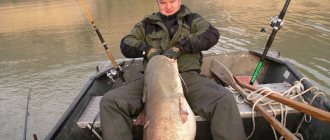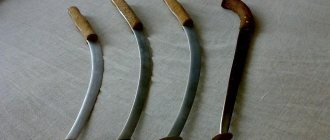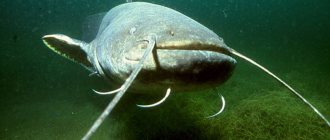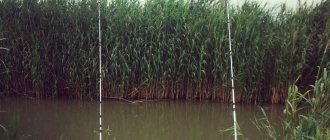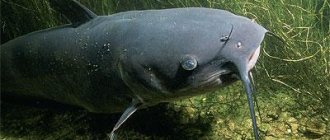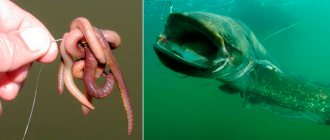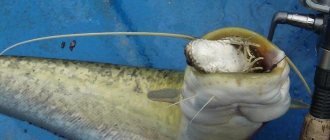Many fishermen want to catch big fish, and for this they need to use not ordinary, but some special gear. Kwok is one of these tools; it is extremely effective when hunting catfish; this tool has very ancient historical roots.
The fact is that the quok makes an unusual sound, the catfish hears it and begins to move in the direction from which it heard the sound. In fact, it is still unclear why the catfish follows this sound. Perhaps the reason for this is that when swallowing food, the catfish produces a similar sound.
Kwok can be obtained in two ways: buy ready-made, or make it yourself. Most fishermen prefer to make the kwok themselves, because in this case they make the tool specifically for themselves, customizing it to their needs.
Content:
- 1 What does a quok consist of 1.1 Availability of drawings
- 1.2 Choosing the right shape
- 6.1 Nodding and why it attracts catfish
This is the only freshwater fish in our reservoirs that grows in length to large sizes and at the same time has an impressive weight. Catfish are nocturnal hunters that can only be caught at night. Probably not everyone knows that it can be caught during the day if you use a quok.
Kwok is a special instrument that makes a sound that attracts catfish. Moreover, no matter when it is used, day or night, the catfish reacts to it and rises from the bottom to the place where this sound comes from. No one knows why he is so attracted to this sound, and it doesn’t matter, the main thing is that he reacts to it.
You can buy a kwok if you don’t want to make it yourself, although it’s not at all difficult to make.
Material selection
To make a quok with your own hands, you will need several types of materials; not only the effectiveness of the bait, but also the ease of its use will depend on the choice made.
Typically, fishermen use the following materials for these purposes:
- To make the handle, you can use plastic; wood; polystyrene foam treated with special solutions or cork material. Most experienced fishermen recommend making wooden handles, since with low weight this material actually does not slip in your hands, even if they get wet.
- The water cutter can be made from virtually any material, but the most preferred option is metal. This will ensure the strength of the knife without increasing its width, will have a positive effect on the service life of the bait, and the movement of the device will be smooth. Thanks to this, you will not need to make any additional efforts and the process of working with the quok will not be so exhausting.
- The most suitable material for the claw is also metal. However, it must be taken into account that its optimal thickness should be at least 2 mm, otherwise the bait will make rattling sounds, which will negatively affect its effectiveness. Working with such thick metal is difficult and requires certain skills, which is why many anglers use epoxy resin. It is very easy to make such a hoove; just pour the melted resin into a mold made in advance from plasticine. The only drawback of the material is the increased degree of fragility of the finished bait.
What does kwok consist of?
The kwok for catching catfish consists of several structural elements, namely:
- Pens.
- Knife.
- Pyataka.
Each design element has its own purpose. The following requirements apply to them:
- The handle should be light, preferably made of wood, and comfortable. The wooden handle will prevent the tool from sinking if it accidentally falls into the water.
- The knife must have a certain thickness and shape, otherwise it will create additional resistance in the water. It can be made from any available material, including wood.
- The nickel is usually made of metal. Particular care should be taken in its manufacture, since it is the one that produces this sound.
Availability of drawings
Drawing a picture of this instrument will not be difficult for anyone. But at the same time, some features should be taken into account. For example:
- First you need to decide on the shape of the future instrument.
- Decide on the size of the handle, since each person has a different palm width.
- The knife of the device is made with a bend. Its length before bending is about 12 cm.
- The total length of the knife should not exceed 22 cm.
- During manufacturing, it should be taken into account that the angle between the handle and the knife should be within 35-40 degrees.
- The knife should have a smooth taper from the handle to the heel.
- The width of the coin can be within 25 mm.
By adhering to these basic recommendations, it will not be difficult to correctly make a quok for catfish.
Choosing the right shape
When making a quok for catfish, it makes sense to consider four options for its design:
- Atanovsky Kwok
. This is the simplest form of kwok, which means it is the easiest to make. This tool has a straight knife, without any bends. The nickel is made in the shape of a rectangle and has rounded edges. The handle is made of wood. - Kiev Kwok
. The Kyiv Kwok knife is not straight, but curved, which complicates the process of its manufacture. In addition, this will require more materials. - Severodonetsk Kwok
. It is somewhat similar to the Kiev one, but does not have such smooth transitions from the knife to the handle. In addition, his nickel has an oval shape. - Hungarian Kwok.
This instrument has a bizarre shape, somewhat similar to a sickle. The knife smoothly transitions into the handle, but at the same time has two bends.
When making a kwok for the first time in your life, you should repeat the simple version (Atanovsky) and only then, if it does not suit you, move on to more complex manufacturing options. The main thing is that the device produces an attractive (for catfish) sound.
Kwok for catching catfish with your own hands: drawings, video of proper production
Kwok is a very effective tool for hunting catfish, which has come to us from ancient times in almost unchanged form. Today, other materials are used to make the kwoka, but the device itself and the principle of operation remain the same as they were.
Despite the fact that there are various versions of quok fish on sale, most fish catchers prefer to make their own beaters for catching catfish. And this is explained primarily not by the desire to save money, but by the fact that it is with hand-made quoks that you can achieve the best results in catching baleen. Let's figure out how to make kwok for catfish with your own hands.
Kwok consists of three main parts :
Each of these parts must be manufactured so that it can best perform its function.
The handle should be comfortable, therefore, it should be made of a pleasant-to-touch material that will not slip in the hand . In addition, if the kwok is not made of wood, the handle should be made of light material to ensure its buoyancy - after all, when biting a trophy, the firecracker can easily be dropped from your hands, and it will be very disappointing to lose a catchy kwok made with your own hands.
The knife , located between the handle and the coin, should not interfere with the formation of bubbles during quoting, the rupture of which causes gurgling sounds attractive to catfish. The thinner it is, the better , in this case it will be as easy as possible for the fisherman to croak, producing the sound of the desired boominess and sonority.
The purpose of the snout is to capture a little air with each blow of the quok on the water and drag the resulting bubble under the surface. It should have as sharp edges as possible , while the patch can be either concave or flat.
- Kwok Atanova;
- Kyiv Kwok;
- Severodonetsk;
- Hungarian.
The Atanovsky quok is the easiest to manufacture version of a mallet for hunting catfish. That kwok has a straight knife that can be cut from steel, duralumin or other metal, a rectangular-shaped metal head with rounded corners and a wooden handle.
The Kiev Kwok differs from the Atanovsky one only in the curved shape of the knife , which smoothly turns into a handle. It is more difficult to make such a kwok with your own hands, and more material will be required to make it.
Severodonetsk Kwok is very similar to the Kiev one, but differs in a steeper curve of the knife and the shape of the penny , which in this model, unlike the previous two, has an oval shape.
The Hungarian quok is perhaps the most bizarre of all the flapper options for catching catfish. It has the shape of a sickle ; the knife, which smoothly transitions into the handle, has two smooth bends.
Stories from our readers. Theme: fishing suit
Georgy V. Kaliningrad – “For me, fishing is half of my life. For as long as I can remember – from the age of 5 with my father until now, I have always been fishing. And if finding a good spinning rod is not a problem now, then with fishing suits it’s a real hemorrhoid. I probably tried about 10 of them. Including the popular fishing slide version. There is nothing truly good. It's cold, it's hot. There are few pockets, but the seams are torn. Half a year ago I ordered another one, a special fishing one. And lo and behold! I didn't expect such good quality. I don’t have any problems anymore - the fabric is excellent, it doesn’t get wet, even in rain, even in hail, even in terrible frost. 11 pockets! I recommend it to everyone! Check out the link below, you'll love it!”
The main materials for making a patch are:
A knife can be made from:
To make a handle you can take:
There are many ways to increase your fish catch, but the most effective ones are. Below, the site editors share with you the 3 most effective ways to increase your catch:
- Bite activator. This is a pheromone-based additive that activates receptors in fish. ATTENTION! Rybnadzor wants to ban this bait!
- Any other baits with flavorings are less effective; it is better if they contain pheromones. But the most effective way is to use the new product of 2016 - DYNAMITE EFFECT!
- Learning different fishing techniques. For example, it is written here about spinning wires.
Even though many quack makers prefer to use wooden quoks, the best today, perhaps, are the quoks, the knife and snout of which are made of metal .
Metal kwok has a number of important advantages :
- ease of use : as noted above, in order to obtain the sonorous “gurgle” necessary to attract catfish, it is best to use quacks with thin knives and snouts with a sharp edge; for this reason, quacks with metal crackers are noticeably easier than with wooden ones;
- ease of manufacture : in order to make a metal quok, you just need to cut out a knife of the desired shape, attach a handle and a snout to it, while with the same wooden quoks everything can be much more complicated;
- durability : well-made metal quok is reliable and durable, it can be considered almost eternal.
The disadvantages of metal include:
- sound less natural and pleasant than that of a wooden quok;
- negative buoyancy.
Speaking about wooden quoks, it can be noted that they are very beautiful, especially if they are carved from a single piece of wood.
However, they are not durable and less convenient to use than metal clappers; it is more difficult to get the desired sound with them, and the angler gets tired faster when fishing with a wooden clapper. Quokas carved from a single piece of wood are very labor-intensive to manufacture .
Since Atanova’s quok is easier than others to make and at the same time no less catchy (as many experienced fishermen say), it is well suited for the first quok made at home .
So, where to start and how to make a kwok correctly?
First of all, we need to prepare materials :
- a sheet of metal 2-2.5 mm thick for making a knife (duralumin works well);
- metal 3-5 mm thick for a penny (you can use aluminum for this purpose);
- wooden slats 20 mm thick and 30 mm wide (for example, oak).
HOW TO CHOOSE A SUIT FOR FISHING?
- The main thing is the fabric and lining. To be warm in winter and not hot in summer. It would be great if it were polyester fabric with a through-cell structure that wicks away moisture and allows the skin to breathe.
- presence of pockets. The more and the better they are located, the better.
- Straps and hood are required. It would be great if the bottom is treated with a drawstring with a cord and clamps
Very few suits have such properties. Even the popular “slide” option for fishing is not what you need. So far, the only option on the Russian market is suits from this online store. This is the quality standard. All requirements above have been met. Look - especially now there is a promotion: 50% discount on your first purchase and a flashlight as a gift!
Materials for making kwok
If a drawing of the future device is already ready, then it’s time to decide on the materials for its manufacture. Each part of the kwok is made from a specific material.
It is possible to make a nickel from:
- metal;
- pour from epoxy resin;
- wood;
The knife is made from:
- metal;
- plastics;
- organic glass;
- wood;
Suitable for making a pen:
- tree;
- neoprene;
- Styrofoam.
The main condition for making a handle is its positive buoyancy. The kwok should be made so that it always remains on the surface of the water and does not sink. Therefore, only lightweight materials, such as duralumin, should be used.
Catfish rig with quok
Fishing with a quok is not only about the ability to work with a high-quality tool. Catching trophy fish requires heavy-duty tackle. There are several options for fishing rods for this method of fishing. Since hunting is carried out from a watercraft, the gear is equipped with a short rod or all the equipment is reeled on a reel
When assembling a fishing rod, it is important to take into account the size of the likely trophy. If there are giants weighing up to 100 kg in a river or reservoir, then each element of the gear must withstand this load
Photo 2. Kvoki made of wood.
Onboard fishing rod
To assemble an onboard fishing rod for catfish, you will need the following fishing elements.
- Both modern sea or carp sticks up to 3 m long, as well as ancient duralumin two-piece spinning rods, are suitable for the role of fishing rod.
Note! A duralumin spinning rod often breaks at the joint. Before fishing, carefully check the security of the fastening.
- Since catfish fishing from a boat does not require long casts, when choosing a reel you can give preference to a metal inertial model of the “Neva” type. If the angler is more accustomed to “meat grinders,” then you should not save. You need to buy carp models with a spool size of 5000 and above. Before you start fishing, you must release the friction brake or use a baitrunner. This is done for the safety of the angler, because with a powerful bite, the fishing rod can slip out of your hands or cause damage to the butt.
- Braided or monofilament can be used as the main line. The breaking force of any thread must correspond to the weight of the intended trophy.
- A sinker weighing 10-30 g is mounted on the main line. Its task is to quickly deliver the equipment to a given depth. Some recommend using a sliding mount, while other fishermen attach the sinker stationary. For catfish fishing, the method of securing the load is not of fundamental importance.
- The leash is made of monofilament or fluorocarbon with less breaking force than the base. The largest treble hook is tied to the end of the leash. When using large live bait, anglers have come up with different equipment with two hooks for catching catfish with a quok.
You can monitor the bite by watching the tip of the rod or wait for the catfish to start unwinding the fishing line.
Tackle on a reel
Many provincial fishermen successfully catch large catfish using simpler and cheaper gear. All equipment is wound on a homemade reel.
- The basis of this fishing rod is a reliable cord. It can be nylon rope, thick monofilament or braid.
- A sinker weighing 20-30 g is tied to the end of the base.
- The first leash is attached above the sinker (0.5-1 m). It is made from monofilament fishing line and a large hook. Most often, anglers use doubles or trebles to form a voluminous bait.
- After another 1 m, a second leash is installed. The number of leashes is usually limited to 1-3 pieces.
With such equipment, the fisherman will not have to get bored from idleness. You should always have a cord in your hand, which allows you to play along with the bait, as well as lower or raise the equipment higher.
The use of gear on a reel poses some threat to the safety of the fisherman. The fact is that when a large catfish bites, the fishing line can become entangled in a person’s arm or leg. A giant fish can easily drag an angler into the water and drown him. Therefore, experienced flyfishers keep a supply of fishing line on the reel, but as soon as a bite occurs, after hooking they immediately release the fishing line.
Metal quoks
When the quok began to be made, all its elements were made of wood. They had both their advantages and disadvantages, considering that wood is not durable, especially in contact with water. Therefore, over time, they began to make quotes from metal, especially nickels and knives.
This is very important, since the metal retains its shape for a long time. In this regard, it should be noted the advantages that metal kwok has:
- A metal kwok, and especially an element such as a nickel, produces the desired sound more realistically. This is achieved due to the fact that the penny can be made of any thickness without worrying that it will become deformed and stop making the desired sounds.
- Easy to make, unlike wood kwok. It turns out to be less massive (volume) and more reliable. In addition, not everyone knows how to work with wood, especially correctly.
- Extended service life. If you make it correctly and get the desired sound out of it, it can last for many, many years.
Despite this, metal quoks also have their disadvantages:
- The wooden kwok has a more pleasant sound to the ear.
- A purely metal quok, if no measures are taken, can easily drown.
As mentioned above, everything needs to be thought through very carefully in terms of the use of materials. Losing a quok on the water is a matter of a couple of seconds, but making it will take a lot of time. Therefore, it is necessary to ensure that the structure always remains afloat. If you make the handle from neoprene or foam plastic, and the knife and coin from thin but durable metal, then the quok is unlikely to drown, but a wooden handle is unlikely to save it.
Fishing tackle
The gear used to catch such powerful fish as catfish has a rather primitive structure. The entire structure consists of a small number of parts, which has a positive effect on its strength and reliability.
Experienced somyatnyaki use two variations:
Classic bottom tackle
Which is equipped with:
- Dense monofilament with a diameter of 1 to 3 mm or nylon cord wound on a homemade reel, most often made of wood. The optimal length of fishing thread is from 30 to 50 m. The reel itself has an asymmetrical shape, with rounded corners. For convenience, the fishing line is wound in the form of a figure eight, this simplifies the process of releasing and rewinding the cord.
- Here it is more advisable to choose a fairly weighty sinker with a mass of 150 to 200 grams. Alternatively, it can be cast from lead or made from soft sheet material. To avoid breaking the loop, the sinker is securely fixed at the lowest point with a rubber damper or lead pellet.
- at the end of the fishing thread to attach the leash. The leash is a fishing line 0.8 - 0.9 thick and 0.5 - 0.6 m long. Given that the predator has many small teeth, it is recommended to use nylon thread.
- A strong hook is a must. To fight a predator whose weight is more than 30 kg, hooks No. 25 - 30 are suitable; for catching catfish weighing more than 40 kg, it is recommended to use hooks No. 36 - 40. There is one nuance here: the recommended models of hooks are not always on sale. In this case, you can make a suitable hook yourself using spring steel wire (material thickness 3-4 mm). An important point: the finished product, in addition to the tip, requires hardening.
Upgraded fishing rod
- An improved fishing rod is made from an old aluminum spinning rod or fiberglass rod. The optimal length of a fishing rod varies between 1.9 – 2.1 m.
- A reliable and high-quality reel is used as component parts As an option, you can use an inertial product “Neva”, a carp “meat grinder” or a marine multiplier. An important point: before you go hunting, the friction brake must be checked for serviceability and adjusted if necessary.
- This tackle, unlike the classic version , does not require powerful equipment; you can use a more elegant type of fishing line with a diameter of 0.8 - 1.0 mm. You need to wind the reel at least 100 m.
- A monofilament line with a diameter of 0.7 - 0.8 mm and a length of 50 cm is suitable as a leash
- The sinker and hook are mounted as on classic tackle.
Kwoki made of wood
Kvoki made of wood have a more attractive and natural appearance. Quokas made from a single piece of wood have excellent qualities. Despite this, wooden quoks are not considered durable and practical, like metal quoks. Although, nowadays, there are a lot of water-repellent materials for wood, which can significantly increase its service life.
Stainless steel kwok
Kwok, made of stainless steel, is perhaps the best option. Such models have a number of advantages:
- by making a kwok from metal, you can easily make a thin knife with minimal resistance to water and a snout with sharp edges, which, as already mentioned, help to easily extract the necessary pops when hitting the surface of a reservoir;
- a well-made kwok made of stainless steel is very durable - unlike wood, it is difficult to damage or break;
- It’s not difficult to make a stainless steel quok; all you need is to cut out a knife and attach a handle and a snout to it.
Many fishermen think that metal quoks are inferior to their wooden counterparts in appearance, but such disadvantages are hardly significant.
How to make a kwok from stainless steel
To make a stainless steel kwok you will need:
- wooden rail for the handle;
- sheet of metal from which the knife will be made;
- a second sheet of metal for making the patch.
The dimensions of the wooden slats should be such that the handle carved from it fits comfortably in the palm of your hand. When making a quok, you need to take this point into account and select a suitable piece of material. The dimensions of a suitable slats are at least 130x30x20 mm, in most cases they should be larger.
To make a cutwater, you can use not only steel, but also duralumin with a thickness of 2 to 3 mm. For a nickel you need a slightly thicker sheet - from 3 to 5 mm in thickness; aluminum or duralumin is also suitable for this purpose.
There is nothing complicated in the process of making a metal knocker, but it requires a lot of concentration and takes quite a lot of time, especially if you are making a beater for the first time in your life.
- Cut a blank for a knife from a sheet of metal - a metal plate 25-30 cm long, 2.5-3 cm wide on one side and 2-2.5 cm wide on the other. The wider side will be attached to the handle, and a patch will need to be mounted on the narrow side.
- Carve a handle from a wooden block, measure it with a protractor and mark the angle at which it will need to be connected to the knife - about 40 degrees.
- Grind down the bottom of the handle on one side - where the quok shoulder will be - and also part of the cutwater, rounding the corner between them.
- Make a cut in the handle to attach the water cutter.
- Try the knife on the handle and determine the length of its working part, that is, the one that will submerge under water at the moment of impact. Then use a file to sharpen the front and back edges of this part.
- Grind a spike from the narrow end of the cutwater that will fit into the koputse.
- To make the hoof itself, cut a metal blank measuring from 40x20 to 50x30. Cut a groove in it that matches the size of the tenon.
- Give the nickel an oval or rectangular shape with rounded edges, and sharpen its edges.
- Connect all parts of the beater. The knife and handle can be glued together. To secure a nickel to a knife, you need to insert a tenon into the groove and rivet the structure.
At this point, the quok is ready - after the glue has dried, you can go fishing with it.
Making a kwok with your own hands
For the first case, a sample of the Atanovsky kwok is suitable, since it is the easiest to manufacture. The most important thing is that the kwok works properly.
First of all, you should do the preparatory work, depending on the material of manufacture:
- If the kwok is made of metal, then you will need a sheet of metal 2-2.5 mm thick to make a knife. The most suitable material is duralumin.
- The nickel is also made from the same material as a knife, but with a thickness of 3 to 5 mm.
- A piece of wood, section 20x30 mm. It doesn’t really matter what kind of wood it is, but it’s better if it’s a durable tree, like oak.
After this, you can proceed directly to its manufacture:
- First of all, the knife is made. To do this, a blank is cut out of a sheet of metal, up to 30 cm long and 2.5 cm wide at the top and 2 cm at the bottom. You can cut a blank from duralumin using metal scissors or another available method.
- 22 cm are measured from the bottom edge of the knife, after which the workpiece is clamped in a vice and the end (bottom) is sharpened.
- At the next stage, the workpiece is cultivated, removing burrs and sharp corners. This can be done with a file, and then the workpiece is sanded using sandpaper.
- After this, they begin to make the handle. For this, a wooden blank with dimensions of 150x35x25 mm is prepared. Taking a protractor in your hands, mark an angle of 35-40 degrees. It is at this angle that the handle should be attached to the knife.
- To secure the knife, a cut should be made in the handle. All joints must be smoothed. The handle should fit snugly and comfortably in your hand.
- A joint is formed at the bottom of the knife, in the form of a short finger.
- The next stage is devoted to the production of a nickel, which is characterized by dimensions such as 45x25 mm. You will have to drill a hole in the center of the nickel so that the finger of the lower part of the knife fits into it. At the same time, on the outside of the nickle it is necessary to form a secret recess using a thicker drill. In this case, the connection between the coin and the knife will be the most durable.
- Using a file, you need to round the edges of the nickel and give it an ellipsoidal shape.
- After precise adjustment of all parts, they are connected into a single structure called kwok. The wooden handle is attached to the product using epoxy glue, and the coin with the knife is attached using rivets. At the same time, you need to rivet carefully and efficiently so that the nickel is not skewed. In addition, after stripping, there should be no shells at the joints so that they do not affect the nature of the sound produced.
Step-by-step guide to making kwoka catfish
Of course, all fishing tackle and fishing equipment can be bought in the store. But a do-it-yourself catfish quok, made according to the rules and bringing regular bites from the river giant, will bring you true satisfaction from the work done and will become the subject of envy and admiration of your comrades in your favorite pastime.
Before we start telling you how to make a kwok with your own hands, let’s tell you what it actually is.
So, kwok is a tool used to attract catfish to bait. During this fishing, the fisherman is in a boat, and the hook and bait are lowered under the water and are located 2-3 meters from the bottom.
This tool consists of three parts, which can be made of the same or different materials, be monolithic or composite.
Regardless of this, the design of the quok includes the following elements:
- A handle designed to hold the tool in the angler's hand.
- The knife that connects all the parts of the quok together.
- Piglet. This is the very element whose contact with water produces this “tasty” sound for catfish.
During Sabaneev’s time, they quacked with a cut cow horn or an instrument made from a single piece of wood; most often, a piece of an apple tree branch was used to make it. Currently, you can find both completely wooden or metal quotes, as well as combined ones. The development of the chemical industry has made it possible to use various plastics for their manufacture.
To summarize, currently quotes are made from materials such as:
- tree;
- metal, most often duralumin;
- plastic;
- their combination.
Of course, the production of a kwok must be carried out for a specific fisherman, because everyone’s body structure is different, but still, approximate parameters for this tool exist, and they must be adhered to.
At first, the following sizes are recommended for beginners:
- Handle length – 100-140 millimeters.
- Blade length – 220-250 millimeters. Here you also need to take into account the height of the sides of the boat.
- The diameter of the coin is about 45 millimeters. Its shape can vary from a perfect circle to a highly elongated ellipse.
- The outer angle of connection between the handle and the knife should be 30-40 degrees.
- The patch is attached to the knife so that its plane makes a right angle with the axis of the handle.
When manufactured according to these parameters, we will obtain the so-called “Atanov” form. It was named in honor of the practical fisherman G. Atanov, who was the first to propose its drawing in the magazine “Rybolov” back in Soviet times.
In addition to this model, there are several more:
- Kyiv. Her knife is smoothly curved and forms a single unit with the handle.
- Severodonetskaya. An analogue of the Kyiv one, it differs in the shape of the heel.
- Hungarian. Curved in the shape of a sickle with the convex forward.
We will describe the production of kwok for the “Atanovsky” version. We made our choice consciously, since thanks to the clarity of the forms, the drawing and the exact dimensions of the elements, it is difficult to make a mistake when working on it.
Having made a catfish tool of this design and tested it in practical fishing, it will be possible to proceed to other models.
All work on creating a quok is divided into several stages.
- Making a knife.
- Making a handle and connecting it to a knife.
- Cutting out a tenon.
- Preparing a nickel.
- Final assembly of the product.
To make the “Atanovsky” quok we will need:
- 2 mm thick duralumin for the knife;
- 20 mm thick aluminum for the handle;
- aluminum 3-5 millimeters thick for the patch;
- wooden strip, preferably oak or ash, for the handle;
- sheet cork for finishing;
- rivets for connecting parts or a piece of thick aluminum wire;
- acrylic lacquer;
- glue.
We start making kwok with our own hands from a knife, since this element ties all the details of the structure together.
- We cut a strip 300 millimeters long from a piece of duralumin. The upper part should have a width of 25 millimeters, the bottom – 20. For work, we use an electric jigsaw or a hacksaw for metal.
Marking and cutting out a knife
Without putting the knife far away, we begin to form the handle. We do it in the following sequence:
- We cut a piece of thick aluminum 150 millimeters long and 30 wide.
- We apply the knife from below at an angle of 40 degrees, mark the line with a pencil.
- Clamping the workpiece in a vice, we make a cut to the specified line. The width of the cut should correspond to the thickness of the knife; this can be easily achieved by putting together several hacksaw blades for metal.
- Insert the knife into the workpiece.
- After checking the angle, drill two holes for the rivets.
- We insert temporary rivets.
- We saw off the excess parts from the handle and knife.
- We take out the rivets and grind the handle blank.
- We cut out handle linings from wooden planks or thick foam.
- We insert the knife into the handle using epoxy glue.
- We insert rivets and finally rivet the parts.
Technique for catching catfish using kwok
As a rule, catfish fishing is carried out by two anglers. This is due to the fact that it is difficult for one angler to cope with heavy prey. Sometimes you come across such individuals that even two fishermen can barely cope. As a rule, fishing is carried out from a boat, using fairly powerful gear armed with massive hooks.
First you need to determine where the catfish is and approach this place. Basically, catfish rest in deep areas of the water area during the daytime. Having approached a promising place, they install the tackle, after which they pick up the quok and begin to “croak.”
Nodding and why it attracts catfish
To make an instrument produce a characteristic sound, you need to work hard. The correct “nodding” technique will certainly interest the catfish. What is most important is that it will be a large catfish, since the “small fish” do not respond to such sounds. During the “nodding” process, the active element of the knife (nickel) is immersed in water no more than 10 cm. The movement of the element itself occurs along an arcuate trajectory. The result should be a sound reminiscent of the moment a cork leaves a bottle.
Oddly enough, this type of sound attracts catfish, and it can immediately rise from the bottom, and along the way get into the area of action of the bait, which can also interest the catfish. The reasons for his interest may be:
- When a catfish swallows prey, it makes a similar sound. It is possible that this sound serves as a kind of signal for catfish to eat.
- The female catfish attracts the male with a similar sound.
Technique for using kwok
The effectiveness of fishing depends on the ability to use such a device. Method of application:
- For greater effectiveness, you should hit the water several times. After this there is a pause, and then the blows are repeated.
- When the catfish starts moving and takes the bait, you shouldn’t rush to hook it.
- After waiting some time for the catfish to swallow the bait, a sharp hook is carried out.
- Once hooked, the catfish will actively resist. This can take a long time, and when he gets tired of struggling, he is pulled out of the water.
- When the catfish is in the boat, it is better to stun it, otherwise it will continue to fight for life.
- Responsibilities are distributed as follows: one angler controls the boat and “sails”, and the other takes care of the gear.
You should never overestimate your capabilities when going catfishing alone, especially on a boat. He can easily turn over the boat along with the fisherman.
Choosing a promising location
The most common places for catching catfish are pits and areas near them. An echo sounder is considered the main assistant in searching for catfish. In addition to deep places, catfish can be found in areas of coastal vegetation bordering steep banks.
You can choose any time for catching catfish, especially if you have such an assistant as a quok. You can fish with it at any time of the day, including during the day, despite the fact that catfish rest during the day.
As for the time of year, the months of July and August are considered the most productive.
Kwok fishing gear
When fishing from a boat, you will need the following gear:
- Basically, a fishing line or cord is used, which can withstand up to 100 kg of weight. The line can be on either a reel or a reel.
- When fishing with a rod, a short but strong rod with guides is suitable.
- A leash is attached to the end of the fishing line, up to 1 meter long and 0.5 to 0.8 mm thick.
- A reliable hook No. 30 and no less is attached to the end of the leash.
- The weight of the load is selected depending on the fishing conditions and the bait used.
Manufacturing process
Let's look at how to make a kwok, the most popular and easiest to perform form - the Atanovsky one. Such a tool will be durable and will be perfect both as a first quok and as a professional tool. First you need to find drawings of the quok on the Internet.
Of course, you can draw them yourself, but usually this does not make much sense, especially if the angler has no experience in making such tools. Nowadays you can easily find the necessary drawings on the Internet.
Drawings from the Internet are not only quite detailed, but also made, as a rule, by practitioners who are aware of important nuances that a beginner may not take into account when developing his own gear.
Next you need to prepare the material. In our case we will use:
- A metal plate 35 long, 2.5–3 centimeters wide and 2–3 millimeters thick. It is better if it is a metal that is not subject to corrosion: duralumin, brass, stainless steel.
- The wooden blank is of such thickness and length that it fits comfortably in the hand - this parameter is selected individually. Typically, the diameter of the workpiece is about 3.5 centimeters, and the length is about 25.
Review of underwater cameras for catfish fishing
In this case, a kwok will be made with a metal knife and a hoof, equipped with a wooden handle. First you need to make a handle. To do this, you need to use a grinding wheel, knife or sandpaper to grind the workpiece to a shape that will fit comfortably in your hand. To get the classic handle shape:
- 0.5 centimeters are removed from both sides of the workpiece and the corners are rounded, obtaining a cross-section of the handle close to a rectangle with sides of 25 and 35 millimeters, respectively.
- The lower part of the handle is sawn off at an angle of 140 degrees.
- A cut is made inside the handle from below at a similar angle, 25 millimeters deep.
At this point the handle can be considered ready. After completing the entire process, it will need to be coated with a moisture-repellent composition. Next you need to make a suitable cutwater. In order to make it you need:
- Cut a piece about 250–270 millimeters long from the plate, depending on the thickness of the handle.
- Grind off about 0.25 centimeters of width on each side near the bottom edge, making the cutwater slightly tapering towards the bottom.
- Insert the upper edge of the cutwater into the cut in the handle, check the angle between the knife and the handle - it should be approximately 120 degrees.
- If the angle is observed, draw out the remaining plates protruding from the handle from the back and cut them off.
- Without removing the knife from the groove, place the handle vertically and draw the lower end of the divider so that the line starts from its upper corner and is strictly parallel to the ground.
- Cut off the excess part of the knife.
- Sharpen the edges of the cutwater so that it can pass through the water more freely, but without fanaticism - this should not make it become a blade that can cut your hand or boat.
At this point the knife can be considered ready. Next, the patch is made. To do this, a rectangle with sides of 25 and 45 millimeters is cut out of the plate, its corners are rounded, and the edges are sharpened by one-sided sharpening from above so that the plane at the bottom is perfectly smooth.
Next, you need to securely connect the resulting elements. In the case of a handle and a knife, this is quite simple - the knife and groove are lubricated with epoxy resin, connected, after which the connection in the center is drilled through and riveted. This design will hold tight.
In the case of connecting a snout with a knife, options are possible. You can cut a slot in the center of the patch, insert the edge of a knife there and rivet it. You can use aluminum brand, epoxy resin or other options as a connection element - in this case, each fisherman himself chooses a fastening that is convenient for him.
In case of connection by riveting, it is necessary to carefully polish the bottom surface of the patch after completion of the process so that it is perfectly smooth. Only in this case will the quok work perfectly.
Thus, making a quok of this shape is quite simple, and a tool made in this way will perform its function in the hands of the fisherman for a long time.
Lures and Lures
Catching catfish involves using the following bait options:
- A bunch of worms, for catching small catfish, weighing up to 5 kg.
- Perch.
- Frogs. Larger catfish are caught with it.
- Rakov.
- Bark beetle larvae.
- Mole crickets or locusts. Effective but difficult to reach attachments.
- Pieces of meat or fish.
- Smoked poultry. You can catch a fairly large catfish.
What is kwok?
Kwok is a kind of beater that makes a specific and attractive sound for fish when it hits the water. The device consists of three parts: a handle, a coin and a knife. How does it work? When the device hits the water, a bubble forms; when the quok comes out of the water, an air bubble rises along with it and bursts. It is this sound that attracts the barbel so much. In terms of the effect of the quok, it is the same as a decoy. Today it is still not clear how exactly the sound of a bursting bubble attracts fish.
How to choose a good quok
When buying a quok, you should pay attention to its buoyancy, as it is very easy to lose it. The most suitable material is light metal in combination with wood or other fairly light materials. In addition, you should pay attention to:
- The shape of a nickel. It is better if it has an oval shape.
- A quok with a large nickel should not be preferred, although some anglers note that a large nickel produces a louder and more attractive sound.
- Comfortable handle.
- Perfect polish. The presence of hangnails, even small ones, will definitely ruin your mood.
How to make a kwok with your own hands?
Kwok does not have to be purchased in a store. It is quite possible to do it yourself, the main thing is to decide on the shape of the future bait. The Atanov form is universal, reliable and lightweight.
Pay attention to the picture:
- Let's start preparing materials. The water cutter will require iron no more than 1.5 mm thick. The handle will also be made from steel, with wood placed on top of it.
- Now you can start manufacturing.
- Using a jigsaw, a cutwater 30 cm by 2.5 cm is cut from a piece of steel. Then the knife is processed to achieve a smooth surface and only then can you start shaping it. Using a protractor, measure the angle at which the handle is attached to the cutwater.
- It is necessary to drill a hole in the handle and cutwater and fasten it together. Ready.
Choosing a fishing spot
Catfish is a fish that is not used to migrating across bodies of water in search of a new place to live. The fish are not used to swimming in schools; underwater inhabitants gather together only during a large migration of fry, which they can feed on.
A hungry catfish, which blends well with the bottom due to its marbled tint, will hide in snags, which make it convenient to hunt. The barbel will attack sharply, from close range. A well-fed fish will never be active, so if there is no bite, look for another place. An active zhor was noticed from 5 to 7 am, but remember that everything is individual. Catfish loves warm currents; barbel avoids cold rivers. We remind you that an important condition for catfish is the presence of deep holes, snags, branches, and underwater vegetation. At the end of the day, the catfish may move to shallow water.
